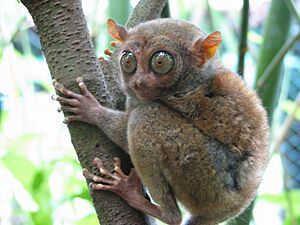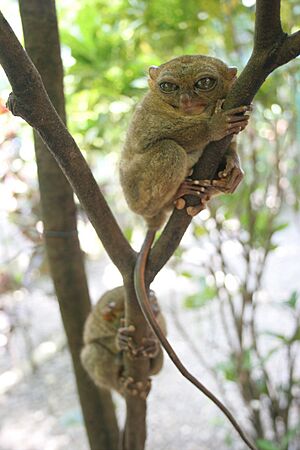Tarsier facts for kids
Quick facts for kids Tarsiers |
|
|---|---|
 |
|
| Philippine tarsier (Carlito syrichta) | |
| Scientific classification |
|
| Kingdom: | Animalia |
| Phylum: | Chordata |
| Class: | Mammalia |
| Order: | Primates |
| Suborder: | Haplorhini |
| Infraorder: | Tarsiiformes |
| Family: | Tarsiidae Gray, 1825 |
| Type genus | |
| Tarsius Storr, 1780
|
|
| Genera | |
|
|
Tarsiers (pronounced TAR-see-ers) are small, fascinating primates. They belong to the family Tarsiidae. Today, you can only find them in parts of Maritime Southeast Asia, like Brunei, Indonesia, Malaysia, and the Philippines. Long ago, they lived in more places around the world. Tarsiers love living in forested habitats, especially where there are lots of vines. These vines give tarsiers vertical support when climbing trees.
Contents
Ancient Tarsiers
Fossil Discoveries
Scientists have found fossils of ancient tarsiers in Asia, Europe, and North America. This shows that tarsiers used to live in many more places than they do today. The fossil record tells us that their teeth haven't changed much in about 45 million years, only their size.
There were also other types of tarsiers that are now extinct. For example, Xanthorhysis and Afrotarsius are two groups of ancient tarsiers that no longer exist.
Here are some fossil tarsier species that scientists have discovered:
- Tarsius eocaenus lived in China during the Middle Eocene period.
- Hesperotarsius thailandicus lived in Thailand during the Early Miocene period.
- Hesperotarsius sindhensis lived in Pakistan during the Miocene period.
- Tarsius sirindhornae lived in northern Thailand during the Middle Miocene period.
Tarsier Family Tree
For a long time, scientists debated where tarsiers fit in the primate family. Now, most agree that tarsiers are closely related to monkeys and apes. This is because they share some important genetic traits. For example, like monkeys and apes, tarsiers cannot make their own vitamin C. They must get it from their food.

Until recently, all tarsiers were grouped into one genus called Tarsius. But in 2010, scientists Colin Groves and Myron Shekelle suggested dividing them into three different groups, or genera. They looked at many differences, like their teeth, eye size, limb length, and even their calls.
These three genera are:
- Carlito: These are the Philippine tarsiers.
- Cephalopachus: These are the western tarsiers.
- Tarsius: These are the eastern tarsiers, found mostly in Sulawesi.
Tarsier Body Features
Tarsiers are tiny animals with incredibly large eyes. Each eyeball is approximately 16 millimeters wide. That's as big as, or even bigger than, their entire brain! Their large eyes help them see well in the dark. They also have excellent hearing.
Tarsiers get their name from their very long ankle bones, called tarsus bones. Their hind limbs are about twice as long as their head and body combined. This special leg structure helps them jump and cling to trees. Their head and body are usually 10 to 15 centimeters long. Their slender tail can be 20 to 25 centimeters long.
Their fingers are also long, especially the third finger. Most of their fingers and toes have nails. But their second and third toes have claws instead, which they use for grooming. Tarsiers have soft, velvety fur, which is generally light brown or beige.
A unique feature of tarsiers is their ability to turn their heads almost 180 degrees in both directions. This means they can see all around them without moving their body. Unlike many animals that see well at night, tarsiers do not have a special reflective layer in their eyes. However, they do have a fovea, which helps them see clearly.
Philippine tarsiers can hear very high-pitched sounds, up to 91 kHz. They can also make high-pitched calls themselves.
Tarsier Behavior
Tarsiers are mostly active at night, meaning they are nocturnal. During the day, they usually rest. All tarsiers are excellent jumpers, thanks to their strong legs. Different types of tarsiers might act a bit differently depending on where they live. For example, Pygmy tarsiers live in high, cold places, which affects how they look and behave.
Tarsiers are very shy animals. They don't like bright lights, loud noises, or being touched. They can get very stressed when they are kept in small cages or handled too much. This is why it's so important for them to live in their natural homes.
Who Hunts Tarsiers?
Because tarsiers are small, many other animals hunt them. They live in the lower parts of trees and bushes to stay safe. They face dangers from animals on the ground, like cats, lizards, and snakes. They also face threats from birds that fly above, like owls. By staying low in the trees, they avoid both ground predators and birds of prey.
Even though tarsiers are shy, they sometimes work together to scare away predators. This is called "mobbing". When a predator is nearby, a tarsier will make a warning call. Other tarsiers hear this and come to help. A group of 2 to 10 tarsiers might gather to bother the predator. This helps reduce the chance of an attack.
What Tarsiers Eat
Tarsiers are the only primates that eat only meat. They are mainly insectivorous, meaning they love to eat insects. They catch their prey by jumping quickly.
Besides insects, tarsiers also hunt other small forest animals. Their diet can include:
- Insects like orthopterans (grasshoppers and crickets), scarab beetles, cockroaches, cicadas, and walking sticks.
- Arachnids (spiders).
- Small flying frogs and lizards.
- Sometimes, even small crabs that climb trees.
Very rarely, they might also eat baby birds, small tree snakes, or baby bats.
Tarsier Life Cycle
Gestation takes about six months, and female tarsiers usually give birth to one baby at a time. When a baby tarsier is born, it already has fur and its eyes are open. Amazingly, it can climb trees within just one day of being born! Tarsiers become adults and can have their own babies by the time they are two years old.
Some tarsiers, like those from Sulawesi, live in small family groups. Others, like the Philippine and western tarsiers, prefer to sleep and hunt alone.
Protecting Tarsiers
It's very hard to keep tarsiers in zoos or other captive places. They need a very specific diet and environment to be healthy. Because of this, they usually don't have babies when they are in captivity.
A sanctuary near the town of Corella, on the Philippine island of Bohol, helps tarsiers. It's called the Tarsier Research and Development Center. Here, tarsiers live in a large, semi-wild area. This area has lots of trees and insects, just like their natural home. A man named Carlito Pizarras, known as the "Tarsier man," started this sanctuary. Visitors can see tarsiers living freely there.
Some tarsier species are in danger. For example, the 2008-described Siau Island tarsier in Indonesia is considered critically endangered. This means it's at a very high risk of disappearing forever. Governments, like in Malaysia, are working to protect tarsiers by listing them in the Totally Protected Animals of Sarawak, on the island of Borneo. This helps keep them safe in their natural habitats.
See also
 In Spanish: Tarseros para niños
In Spanish: Tarseros para niños



